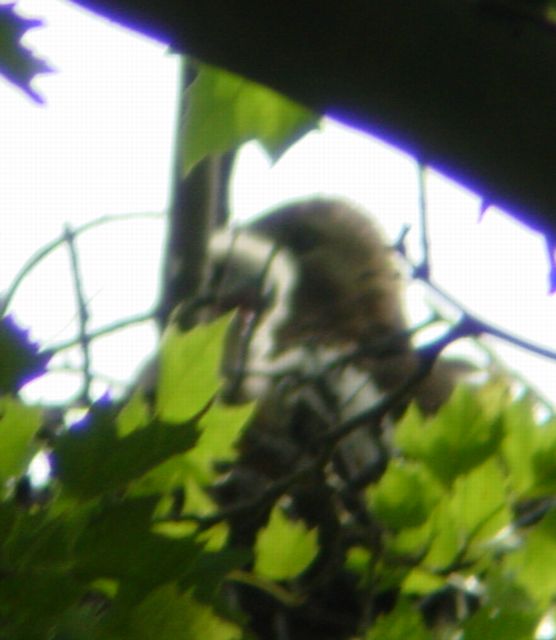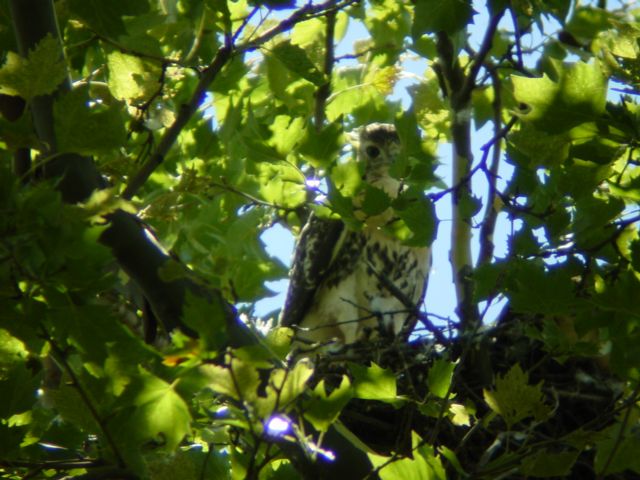January 1, 2005
The Red-tailed Hawk has become a sort of symbol in Central Park.
If this page were really serious about documenting the nature news around here Iíd have posted by now regarding the controversial ousting of the Fifth Avenue pair from their nest. In fact, youíve probably seen plenty of coverage, as the spirited protests that ensued received heavy coverage at both local and national levels.
For truly local coverage the source is Marie Winn, who wrote the book on the Hawks to begin with. Her page has collected news stories, insider gossip, and expert opinion as the events unfolded. As of today, it looks like the birds are prepared to rebuild, and a collective sigh of relief is being heaved, accompanied by a certain sense of accomplishment; a sense of the motivational power of our attachment to nature. It seems that the building management was simply oblivious to (if not contemptuous of) the depth of the devotion that these birds have inspired, not to mention their international celebrity, spread by Marieís book, as well as a more recent (and rather less informed) documentary film.
The Hawks are truly a great story, and have thrilled and delighted, and occasionally saddened us, for over a decade now. Their cachet is in their perfect location, which is exactly at the edge where Park meets City. That was the edge that first fascinated me about Central Park, many years ago. But it drew me in, and eventually I got more interested in the natural phenomena on display deeper within the Park. Yet the context of the city remains ever-present and it is that which makes the Park truly magical, serving to render the mere presence of nature in any degree a full-blown wonder.
The long-term breeding success of the Red-tails has come to represent the possibility of rapprochement between the city and the countryside it displaced. The co-op board only acted like the farmers who used to shoot at hawks (whether they were after livestock or not) but most of us would like to be closer to nature than we are. ďOurĒ Red-tails are a particularly spectacular yet self-contained instance of something that needs to happen on many levels.
As such, they do indeed become symbolic. Like many symbols, their cult has a few zealots, and perhaps itís possible some get a bit obsessive. For my part, I need to wander, and I havenít spent too much time with the Fifth Avenue birds lately, but I honor them, and their defenders. Their success feeds the heart.
None of which is to say that I ignore Red-tails in general. They are photogenic. One year ago I used a picture of one taking flight to symbolize the New Year. Now weíre back again, but this yearís birds are more embodiment than symbol.
Actually, last yearís bird is likely one of the pair I showed on April Foolsí Day. As I speculated, they nested in the North End of the Park, high in a Planetree just off the North Meadow. They played to a much smaller audience than their famous neighbors (and perhaps parents.) But these birds finally came through with the first successful nest actually within Central Park that anyone seems to be aware of. There are nests elsewhere around the city, and a few recent failed attempts in and around the Park, but this time three youngsters were fledged from the late-hatching nest.
That too fed my heart.
For me it was more intimate than the Fifth Avenue scene, yet also less personal; just Red-tails, doing what they do. These birds donít have individual names, like Pale Male, only the species name of Red-tail. That means that the specificity of the symbolic is beginning to be distributed over a population, pointing towards a day when Hawks in the city become a familiar sight, though I should think no less a wondrous one.
Each Year brings forth something new, even if itís just more of the same old Hawks. That trick in and of itself is pretty amazing. And it gives us reason to put stock in the eternal hope of the New Year. If the city can be hospitable to Hawks, then thereís hope that we can make the World a more hospitable place for all of us.
May we do so in 2005.

A fuzzy picture of a fuzzy little bird.
On June 16th, weeks behind the Fith Avenue schedule, you could just see the first chick peeking out from the nest, with the head of the mother directly behind.
Below is a slightly better view, though the nest is well concealed in dense foliage, more typical of how Red-tails nest ďin the wild.Ē You can just see one big eye in between the leaves, betraying the age of the swiftly growing bird on July 6th. Not long after, it was flying, and now, who knows? Perhaps the three young are among the number of Red-tails that can be seen in the Park during the Winter, but eventually they will have to move on and establish their own territories if they wish to emulate their ancestors' success. Itís over a mile between the new nest and the Fifth Avenue site, and itís not clear how many pairs the Park can support, but we may hope that they continue the colonization of our environs in what promises to be a big year for them.
